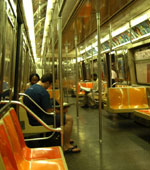Some 4.5 million people use the 100-year-old
New York City Subway every business day
By Lawrence G. Reuter, President MTA New York City Transit
19 April 2004: By the late 1800s, New York City's promise and potential were constrained only by the sluggishness demonstrated by a mass transit system that was becoming somewhat frayed around the edges. Electric streetcars, omnibuses and steam-powered elevated trains could carry passengers only limited distances from the Lower Manhattan business center in anything like a reasonable time. Manhattan Island north of Greenwich Village was the suburbs and anything much farther out than that was country, certainly impractical for a regular commute.
It was clear that in order to prevent the city's development from stalling, the pace of mass transit would have to be picked up considerably. Intriguing was an idea that had been first introduced at least three decades earlier - an under street railway that could speed beneath traffic, unaffected for the most part by weather conditions. Concrete plans for the construction of the subway, however, awaited the technology that would allow electric propulsion and multiple-unit operation.
Politically, solid plans for an underground transit system needed the will of the New York City administration to sweep aside the financial concerns of the operators of the city's antiquated elevated train and trolley systems. Financially, then as now, the ambitious project required generous amounts of funding for a major investment in the public good and the continued growth of the city.
As a city, New York is a full 240 years older than the oldest segment of its subway system. In many ways, though, it did not begin to form its true and modern identity until the first subway train rolled north out of the old City Hall Station on 27 October 1904.
Once the first line was open, New Yorkers swarmed the new railroad and the city's appetite for underground rapid transit only grew. Extensions to the boroughs of Bronx and Brooklyn soon followed and in 1915, the Interborough dipped beneath the East River and roared into Queens through the Steinway Tube, which had been originally constructed for streetcars.
Composed of a staggering sum of superlative statistics, the subway has managed to capture the imaginations of generations of New Yorkers, commuters, tourists and even movie makers. The longest subway line, the ‘A’ Eighth Avenue Express, stretches more than 32 miles (51 kilometres) from a point near the northern tip of Manhattan to the extreme south-east section of the borough of Queens. The deepest station is located 180 feet (60 metres) beneath the bedrock of 191st Street in the Washington Heights section of Manhattan on the 1/9 Lines. The highest, perched 88 feet (29 metres) above street level, serves the F Line at Smith and Ninth Street in the Gowanus section of Brooklyn. But the system is about far more than sheer numbers. Without the subway, New York would hardly be the economic powerhouse it is today.
Over the past 100 years, the New York City Subway has evolved and grown from a nine-mile line to a four-borough system consisting of 26 lines and 468 stations. Carried on upwards of 600 trains, more than 4.5 million people depend on it each business day to reach their destinations.
The 722 miles (1,155 kilometres) that make up the New York City subway are actually a combination of three separate subway endeavors -- the privately-owned IRT and BMT Lines and the city-owned and operated IND or Independent. Since 1940, the three systems have been joined as a common operation, though through architecture and operation they have managed to retain much of their individual personalities.
Most of the system was built between 1900 and 1936, making the first third of the 20th Century a vitally important period for the development of the city's mass transit system. Even now the desire for new subway routes is not fully satisfied. In fact, planning for the construction of the Second Avenue subway line is well under way and when it is completed, passengers along Manhattan's East Side will benefit from a high tech 21st Century subway line, that ironically will relieve much of the pressure on the century-old East Side IRT.
Though it is indeed called the subway, New York City's rapid transit system runs in tunnels beneath the streets but also rises to travel atop elevated structures, along grade level right-of-way and in open cut service. Subway design and construction was varied to match the conditions and topography of a city that is incredibly diverse geographically.
The subway's designers, for the most part, planned the railroad in such a way as to not just meet the demands of the time, but also future requirements of a city bursting at the seams with promise and new development. One of the most important elements of the New York City subway system is the four-track design that allows local and express services and also provides the flexibility required to operate around service problems.
New York City subway cars have always been designed and manufactured to be extraordinarily durable. Service lives of upwards of 35 years are not unusual and with stainless steel construction, common since the late 1960s, cars will remain in service even longer.































